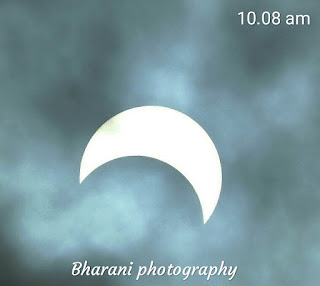The solar eclipse witnessed today (26th
December 2019) matched with Drona’s description of lunar eclipse in Mahabharata
as indicative of Bhishma’s fall. On the 10th day of the Mahabharata
War Drona started noticing inauspicious nimittas all around him. Noted by Vyasa
as a knower of ‘nimittajñaḥ’
in that context, the nimittas narrated by Drona includes a peculiar description
of Moon rising with its horns downwards. Drona says, (Mbh: 6-108-12)
apasavyaṃ
grahāś cakrur alakṣmāṇaṃ niśākaram
avākśirāś ca bhagavān udatiṣṭhata candramāḥ
avākśirāś ca bhagavān udatiṣṭhata candramāḥ
The reference to ‘apasavyaṃ
grahāś cakrur’ is a clear indication of the circular movement of
apasavyam graha – a common reference to Rahu or Ketu. The circular movement of
the graha (Rahu/ Ketu) in apasavyam caused the inauspicious rising of the moon
with its head downwards. The word ‘avākśirāś’ refers to the moon’s ‘heads downward’
which is just opposite of the normal appearance of ‘heads up’ when the crescent
moon rises. The pointed ends of the crescent moon are generally recognised as
‘horns of the moon’. When they are described downwards, it refers to lunar
eclipse. The same refers to solar eclipse too.
On the 3rd day of the war this was
noticed (lunar eclipse) and Drona was worried about the outcome of this as a
nimitta. The outcome appears within seven days. On the 7th day (10th
day of the war) Drona noticed too many inauspicious nimittas and started
worrying that something bad was going to happen to Bhishma, the leader of the
army. No Mahabharata researcher had taken note of this verse on lunar eclipse.
Coming to the solar eclipse of today, it started at
the end of the 1st part of rising. The duration of the day (or night
in the case of Lunar eclipse) must be divided into seven and the part in which the
eclipse occurs must be noted down. The eclipse started at the end of the 1st
part and covered the entire 2nd part. The 1st part stands
for Brahmins, temple etc and the 2nd part for Kshatriyas (army,
police) etc.
Entry from top right, i.e. south east.
At peak (below) the sun looked like an upright
crescent. The southern part of the sun completely eclipsed.
At the time of exiting, the moon slid through west, North
West of the solar disc, making the sun appear like an inverted crescent with
horns down. (below)
This remarkably matches with Drona’s description of
rising moon with horns down due to apasavyam graha’s circular motion! I made an
illustration of it (below).
Lunar eclipse on the 3rd day of
Mahabharata war
· Today’s
solar eclipse ratifies my interpretation of the Mahabharata verse that horns-down
position refers to an eclipse.
· In
Mahabharata it was an eclipsed Full Moon on the rise. Today the same appearance
was seen at the end of the solar eclipse.
· Drona
anticipated harm to Bhishma, which means the eclipse must have lasted for the most
of the 2nd division out of 7 divisions of time.
· Today’s
solar eclipse lasted throughout the 2nd division that indicates harm
to Kshatriyas. Army, police, army go-downs, weapons etc.
· Fortunately
there are no inauspicious nimittas at the time of the solar eclipse. In
contrast everything went wrong on the day of lunar eclipse in Mahabharata (3rd
day). On that day Arjuna formed Ardha-chandra Vyuha
with Bhima and himself standing at the two tips of the horns of the vyuha. It
was the worst day for Pandavas that forced Krishna to throw the discus on
Bhishma. He was pacified by Arjuna and the war of the day ended low for the
Pandavas.
The comparison ends here which I wanted to record as proof for a rare spectacle of horns-down position of the eclipse.



